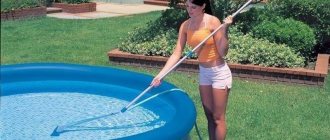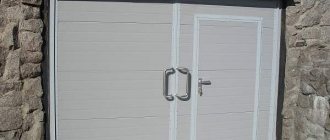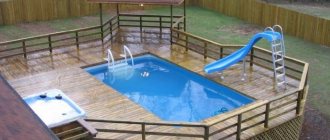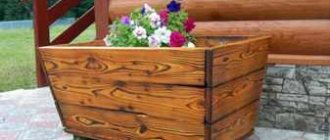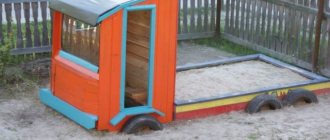Spending a few summer days at the dacha is always pleasant, but if there is also a swimming pool there, the holiday becomes simply luxurious!
The one who managed to convince his wife that the bathhouse was desperately needed and that the tomatoes that were supposed to be planted in its place would still be eaten by the Colorado potato beetle - solved the most difficult part of the problem.
But complete victory is still far away. Now it is necessary to think through and ensure the removal of dirt, microbes and various debris from the water, otherwise the cool, sparkling refuge from the summer heat will very quickly turn into a musty swamp. In this article we will talk about water purification systems and learn how to make a sand filter for a pool with your own hands.
What types of pool filters are there?
Today, there are many different devices that are ready to diligently take care of the cleanliness of your pool.
All of them can be divided into several groups:
- Chemical : the cartridges of such filters contain an active substance that has disinfecting properties. It mercilessly deals with bacteria and microbes that wish to join you without an invitation. Devices of this type are impressive in size, but this is not their main drawback. The fact is that the bather himself is to some extent exposed to the effects of the filter filler, which, alas, does not improve health. Therefore, you won’t be able to splash around in the pool for a long time; in addition, after swimming you will definitely need to take a shower.
- Mechanical : water is pumped through a layer of substance that acts as a very fine sieve. The filter does not have a bactericidal effect on microorganisms, but the largest of them are still retained. At the same time, the cost of mechanical filters, as well as their size, is much less than that of chemical ones. Unfortunately, the performance of these devices is equally low, so it is advisable to use them for cleaning only small pools.
With regard to chemical filters, the principle “the more expensive the better” is especially evident. Those who had to use both cheap and expensive devices noted a significant difference in the degree of impact on the skin. So the conclusion is obvious: when purchasing a filter of this type, attempts to save money will be very inappropriate.
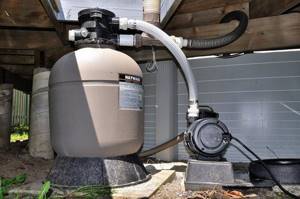
Sand filter after installation
Based on the type of filler, mechanical filters are divided into the following types:
- Sand: the advantages of a sand filter are its low cost, and also the fact that such a device can easily be made with your own hands. True, it is not highly efficient: all particles with sizes less than 20 microns (microns) will again end up in the pool. To clean the filter (an operation carried out approximately once a week), a large amount of water is required, which is pumped in the opposite direction, after which it is discharged into the sewer. Sand is often supplemented with layers of gravel or activated carbon, which helps to increase the efficiency of the filter.
- Cartridge : filters in this category occupy an average position in both price and efficiency. The device consists of a housing and replaceable cartridges installed in it - up to 4 pieces. The latter are made of paper and polyester. All particles larger than 5 microns are retained. An important advantage of cartridge filters is ease of maintenance: the cartridge can be quickly washed under running water, and when its service life comes to an end, it can be easily replaced with a new one.
- Diatoms (terrestrial) : Sedimentary rocks formed by the fossilized remains of ancient diatoms are a very effective filter substance. In addition, the effect of such soil on water can be considered healing due to the high concentration of silicon dioxide in it. The device cannot cope only with those contaminants that are less than 1 micron in size. As with sand filters, periodic backwashing with water is required.
The disadvantages of diatomaceous earth filters are their high cost and the need to hire a specialist to replace the filler, which is due to its high toxicity.
Varieties
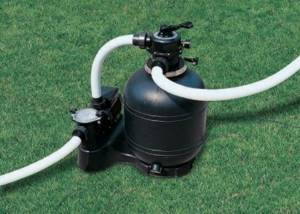
Depending on the substance used for filtration, devices are divided into four main types:
- Paper . They use specially treated paper as a filtration material. The obvious advantage of such equipment is its environmental friendliness and the absence of chemicals in the filters. In addition, paper filters are very economical (the cheapest cartridge for them costs from one hundred to two hundred rubles).
- Sandy . To purify water, use a container with quartz or glass sand. Sand filters for pools show higher efficiency compared to paper ones, but they have two significant drawbacks. The first is that they are larger in size (they have a special plastic barrel for sand). The second is the high energy consumption (in order to drive water through a barrel of sand, you need a powerful pump, and it consumes a lot of electricity).
- Chlorides . Instead of a filter, such devices have a chlorine generator, which is capable of producing chlorine ions from ordinary table salt under the influence of electric current. Such equipment does not require a lot of electricity and effectively disinfects the water in the pool. In addition, thanks to the fine mesh grid placed inside, it removes small debris from the tank. There is no need to change filters - just fill the unit with salt from time to time. The only drawback is the constant presence of a slight smell of bleach. Not everyone will like this.
- Cartridge . The cleaner is a cartridge filled with a special chemical composition. It not only removes dirt and debris from the water, but also disinfects it thanks to the antiseptic agents included in the cartridge.
Sand filter device
A sand filter for a pool is a container filled with sand, into which pipes are cut in at the top and bottom. There is also a tight-fitting lid with a lock. There is a fitting cut into the cover for connecting a pressure gauge.
The latter helps to assess the degree of filter clogging: if the pressure increases significantly when pumping water, then it’s time to rinse the sand.
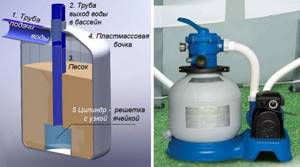
Sand filter device
The filter is switched to the washing mode by switching the valves. In this case, water begins to enter the device not from above, but from below - this is called backwashing. At the same time, a drain valve opens at the top, through which dirty water is discharged into the sewer.
In the “Washing” mode, the filter should work for about 5 minutes. Then the valves are switched to the “Tamping” mode and only then (also after 5 minutes) – to the “Filtration” mode.
Roof drainage is an important element of the drainage system, because proper drainage will ensure the safety of the building and foundation. How to properly drain water from a roof? Let's consider the types of drainage systems, materials, as well as installation features.
Read about making a septic tank with your own hands and using barrels here.
And in this topic https://aquacomm.ru/vodosnabzenie/zagorodnyie-doma-v/avtonomnoe-vodosnabzhenie/istochniki/kolodets/kopka-svoimi-rukami.html you will learn how to properly dig a well with your own hands. Selecting a location, protection from surface contamination, design of the above-ground part.
Homemade sand filter for the pool - step-by-step manufacturing instructions
When arranging a swimming pool, you can save a certain amount (from 6.5 to 13 thousand rubles) by installing a homemade sand filter made with your own hands instead of a purchased one. In the step-by-step instructions below, the entire process of manufacturing a cleaning device is discussed in as much detail as possible.
We select sand
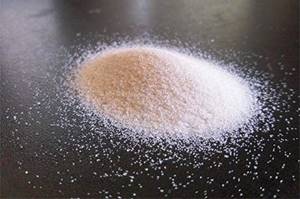
This point can be considered key, because the effectiveness of the filter depends on how much sand is “charged” into it.
The most effective and durable is glass, but it cannot be called affordable.
In most cases, quartz sand is used, the service life of which is about 3 years.
As practice has shown, fractions from 0.5 to 1.4 mm have the best filtering ability.
River sand, which is also called beach or quarry sand, cannot be used as a sand filter filler.
Sand, which is sold in stores specifically for filtration units, can be used without prior preparation. If the material gets to you through other means, it must be boiled, first rinsed with clean running water.
You can buy quartz sand at any hardware store; the approximate cost of a 25-kilogram bag is 600 rubles.
Case manufacturing
The plastic or metal container from which the filter housing will be made should have a volume of 40 to 60 liters. It is mandatory to have a tight-fitting lid with a secure lock.
The container must be equipped with two fittings: one (input) is cut into the upper part, the second (outlet) - at the very bottom. The insertion points should be carefully sealed.
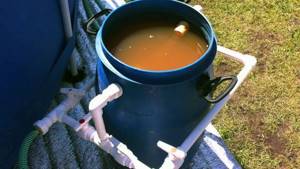
Homemade sand filter
On the lower hole on the inside of the body you need to attach several layers of nylon mesh, which will hold the sand filler.
A coarse filter is installed at the inlet - a nylon mesh attached to a piece of plastic bottle.
Another fitting - for connecting a pressure gauge - should be cut into the cover.
Sand filling
Filling of the filler should be done with the simultaneous supply of water. As already mentioned, the filter can be made multilayer, using, in addition to sand, gravel, as well as activated carbon or graphite.
The coarsest sand should be poured in first, then the finer ones. If this principle is followed, filter washing will be faster and more efficient.
Assembly and connection
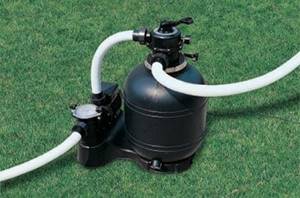
When filling is completed, the filter is closed with a lid, onto which a pressure gauge is then screwed.
A hose coming from the pump is connected to the upper fitting using a clamp, and another hose for draining water into the pool is connected to the lower fitting.
To flush the device, the hoses are connected according to a different scheme: the line from the pump is connected to the lower pipe, the drain leading to the sewer is connected to the upper.
At first you will have to do this every day, but as the water purifies, the need for flushing will arise less and less.
A piece of plastic bottle with a nylon mesh - an improvised coarse filter - can be fixed not in the sand filter, but on the suction pipe of the pump. In this case, the entire filter system will be under its protection.
It is impossible to live without water in a summer cottage. In addition, the water must be of high quality and it must be supplied uninterruptedly. How to find water for a well on a site? Let's consider methods for detecting groundwater: analysis of vegetation, the help of absorbents and other methods.
We will discuss the operating principle of a vortex pump in this section. Comparative characteristics of centrifugal and vortex pumps.
Filtration System Manufacturing Guide
When creating a sand filter, proceed as follows:
- wash the sand with warm water until the liquid becomes transparent, thereby removing particles larger than 1.5 mm;
- remove bacteria by boiling sand in a deep container over a fire;
- fill the filter with sand under running water, add graphite or activated carbon to it in order to improve the quality of the water;
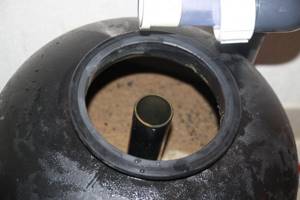
The substance is poured not in dry, but in raw form - create 2 holes in the tank, the diameter of which is the same as the size of the drains for the pipes, and close them with a hermetic substance;
- a coarse filter is placed at the bottom of the container, which will expel water into the pipes and then into the pool;
- Hoses are attached to the device using hot glue, and a grid is installed on the inside of the joint, the task of which is to separate the flow and ensure a uniform supply of liquid to the filtration system;
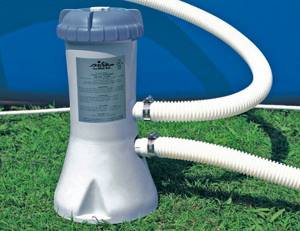
The hoses must be securely fastened - The tank lid is secured so that it does not come off under the influence of water pressure.
The filter is installed according to the rules. The mechanism must be installed so that no “dead zones” are formed that prevent water from entering the fence. The filter should draw liquid from the surface of the pool, where most of the contaminants float. But the drain hole can be located anywhere in the pool and at different depths. It is important to provide free access to the filter in order to be able to replace sand without problems.
Video about creating a filter for a pool with your own hands
Nuances of operation
When using a sand filter, you should follow the safety rules:
- install the mechanism at a distance of 1 m from the walls of the pool;
- place the pump in a place where air will be available to it;
- regulate operation only when the pump is turned off.
Over time, lime will accumulate in the filter, which will negatively affect the operation of the mechanism. Therefore, after 4–6 months of operation, the sand filter must be cleaned using a composition that removes lime deposits.
After a few years, the sand in the filter will need to be replaced. To do this you need to do the following:
- turn off the pump;
- unscrew the valve and empty the pool of water (if the filter is not in the pool, but is connected to a hose, then this is not necessary);
- lift the tank lid and remove the sand using a technical vacuum cleaner;
- Clean the nozzles with water so that no dirt or sand remains on them;
- fill the tank with a new portion of sand (pour larger grains to the bottom, and lay fine sand on top of them).
Sand replacement
Ordinary quartz sand must be replaced every three years. Some purchased installations (for example, Intex sand pool filters) use sand, which requires replacement less frequently - approximately once every 5 years. The operation is not difficult at all:
- Turn off the pump supplying water to the filter.
- If you are using a factory-made filter system, close the nozzles and close the skimmer valves.
- If the filter is installed inside the pool, the water from the bath must be drained.
- Disconnect the filter from the system.
- After opening the hatch, remove all sand from the housing, not forgetting to clean the nozzles.
- Lay new sand under water pressure. As mentioned above, the bottom layer should be formed by the coarsest sand, then the material of the middle fraction is laid, and the finest sand is laid on top.
- All that remains is to close the filter cover with the latch and connect it to the system.
After each sand filter maintenance operation, be it changing the sand or washing it, check that the pressure gauge hole is not clogged with dirt or sand.

